Nursing Ethics and Legal Frameworks Presentation: NURBN 1001
VerifiedAdded on 2022/07/28
|6
|1141
|51
Presentation
AI Summary
This presentation examines the nursing code of ethics, legal frameworks, and patient rights in the context of a case study involving a patient named Peter. It addresses key concepts such as the Nursing Code of Conduct, the Australian Charter of Health Care Rights, duty of care, the reasonable standard of care, and medical negligence. The presentation highlights the importance of adhering to professional standards, proper documentation, and effective communication among healthcare professionals to ensure patient safety and positive health outcomes. The case study reveals breaches in these areas, leading to a patient's deterioration and death, which underscores the need for accountability and adherence to ethical and legal guidelines in nursing practice. The role of the coroner is also discussed in relation to investigating suspicious deaths.
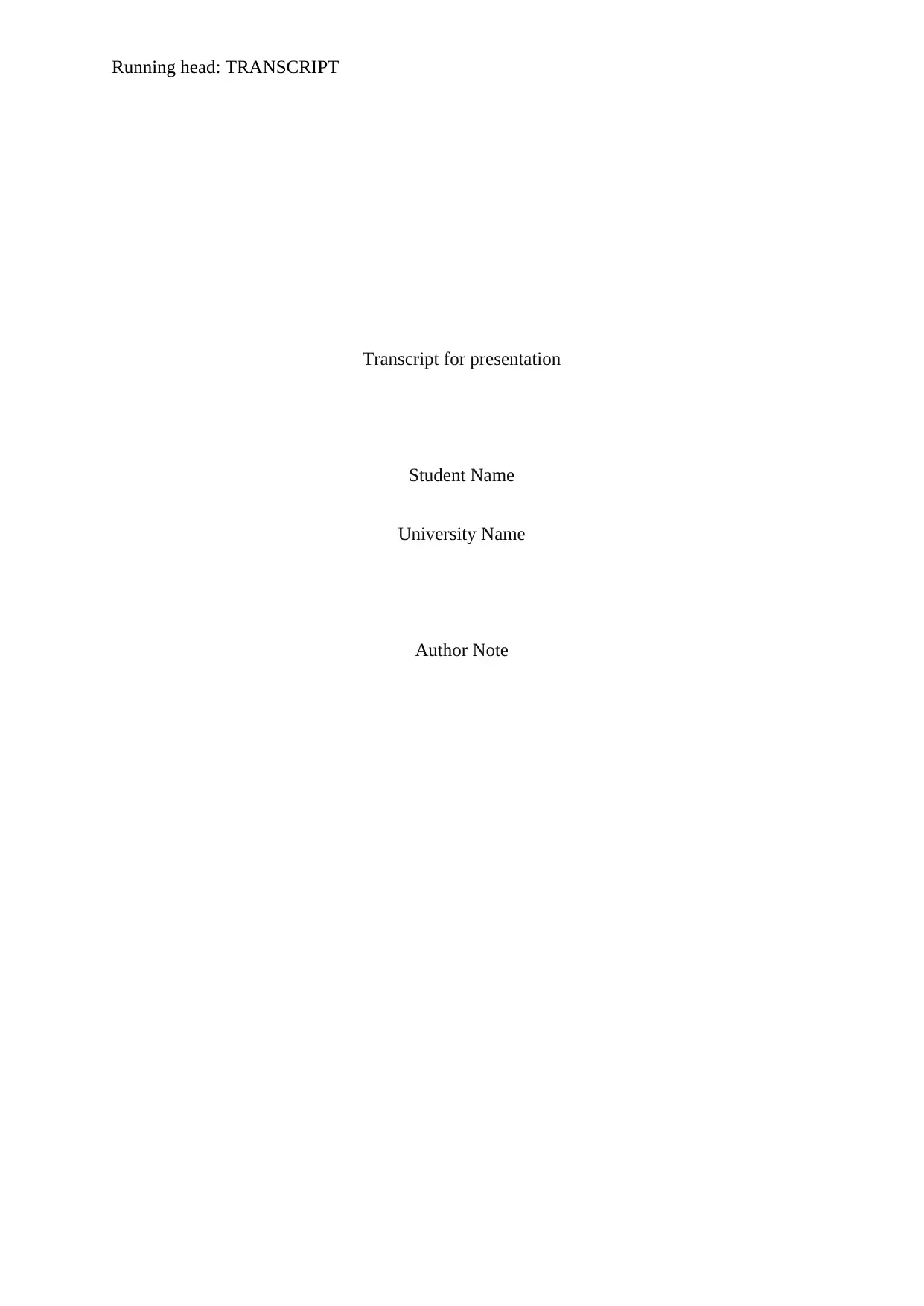
Running head: TRANSCRIPT
Transcript for presentation
Student Name
University Name
Author Note
Transcript for presentation
Student Name
University Name
Author Note
Paraphrase This Document
Need a fresh take? Get an instant paraphrase of this document with our AI Paraphraser
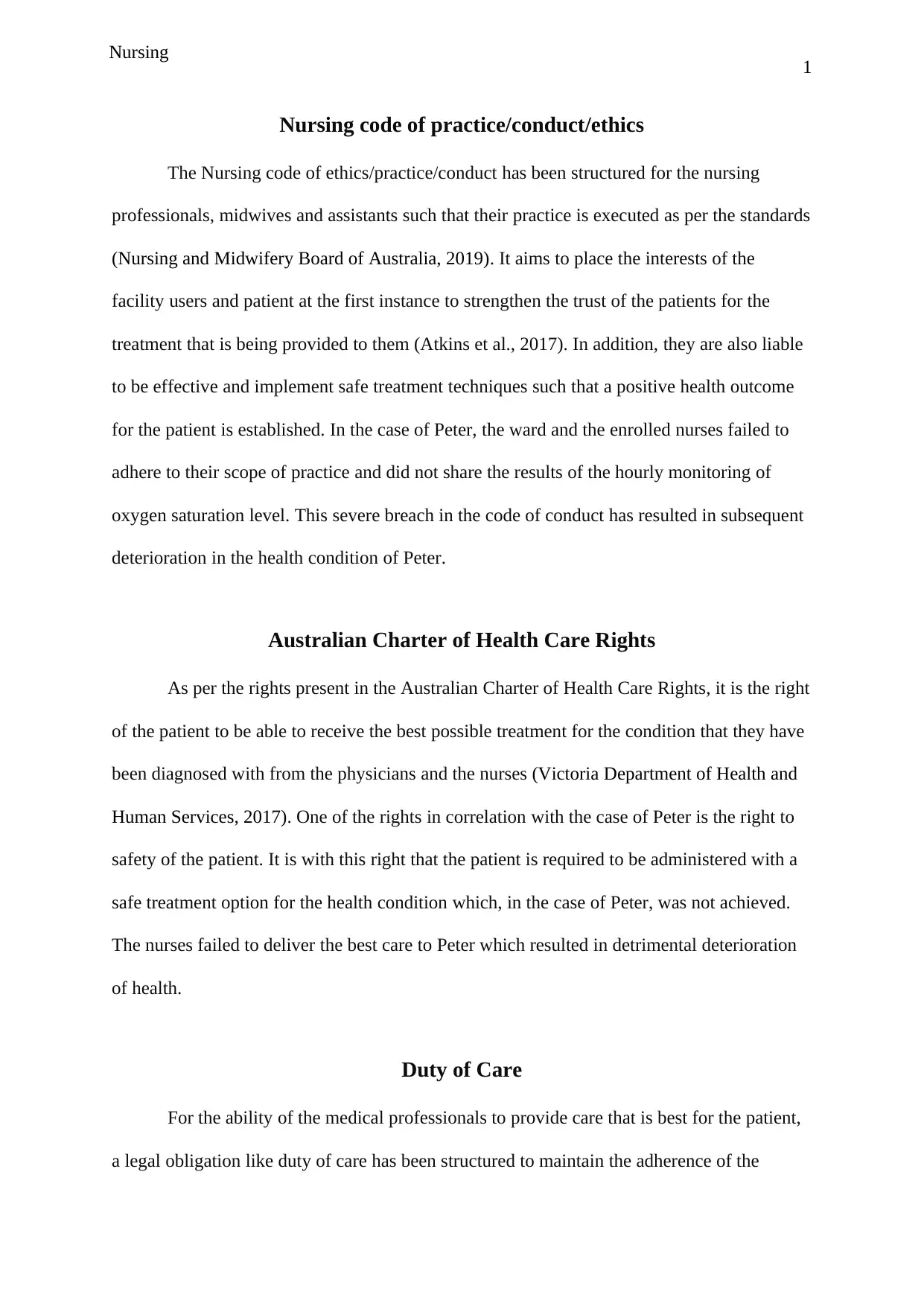
1
Nursing code of practice/conduct/ethics
The Nursing code of ethics/practice/conduct has been structured for the nursing
professionals, midwives and assistants such that their practice is executed as per the standards
(Nursing and Midwifery Board of Australia, 2019). It aims to place the interests of the
facility users and patient at the first instance to strengthen the trust of the patients for the
treatment that is being provided to them (Atkins et al., 2017). In addition, they are also liable
to be effective and implement safe treatment techniques such that a positive health outcome
for the patient is established. In the case of Peter, the ward and the enrolled nurses failed to
adhere to their scope of practice and did not share the results of the hourly monitoring of
oxygen saturation level. This severe breach in the code of conduct has resulted in subsequent
deterioration in the health condition of Peter.
Australian Charter of Health Care Rights
As per the rights present in the Australian Charter of Health Care Rights, it is the right
of the patient to be able to receive the best possible treatment for the condition that they have
been diagnosed with from the physicians and the nurses (Victoria Department of Health and
Human Services, 2017). One of the rights in correlation with the case of Peter is the right to
safety of the patient. It is with this right that the patient is required to be administered with a
safe treatment option for the health condition which, in the case of Peter, was not achieved.
The nurses failed to deliver the best care to Peter which resulted in detrimental deterioration
of health.
Duty of Care
For the ability of the medical professionals to provide care that is best for the patient,
a legal obligation like duty of care has been structured to maintain the adherence of the
Nursing
Nursing code of practice/conduct/ethics
The Nursing code of ethics/practice/conduct has been structured for the nursing
professionals, midwives and assistants such that their practice is executed as per the standards
(Nursing and Midwifery Board of Australia, 2019). It aims to place the interests of the
facility users and patient at the first instance to strengthen the trust of the patients for the
treatment that is being provided to them (Atkins et al., 2017). In addition, they are also liable
to be effective and implement safe treatment techniques such that a positive health outcome
for the patient is established. In the case of Peter, the ward and the enrolled nurses failed to
adhere to their scope of practice and did not share the results of the hourly monitoring of
oxygen saturation level. This severe breach in the code of conduct has resulted in subsequent
deterioration in the health condition of Peter.
Australian Charter of Health Care Rights
As per the rights present in the Australian Charter of Health Care Rights, it is the right
of the patient to be able to receive the best possible treatment for the condition that they have
been diagnosed with from the physicians and the nurses (Victoria Department of Health and
Human Services, 2017). One of the rights in correlation with the case of Peter is the right to
safety of the patient. It is with this right that the patient is required to be administered with a
safe treatment option for the health condition which, in the case of Peter, was not achieved.
The nurses failed to deliver the best care to Peter which resulted in detrimental deterioration
of health.
Duty of Care
For the ability of the medical professionals to provide care that is best for the patient,
a legal obligation like duty of care has been structured to maintain the adherence of the
Nursing
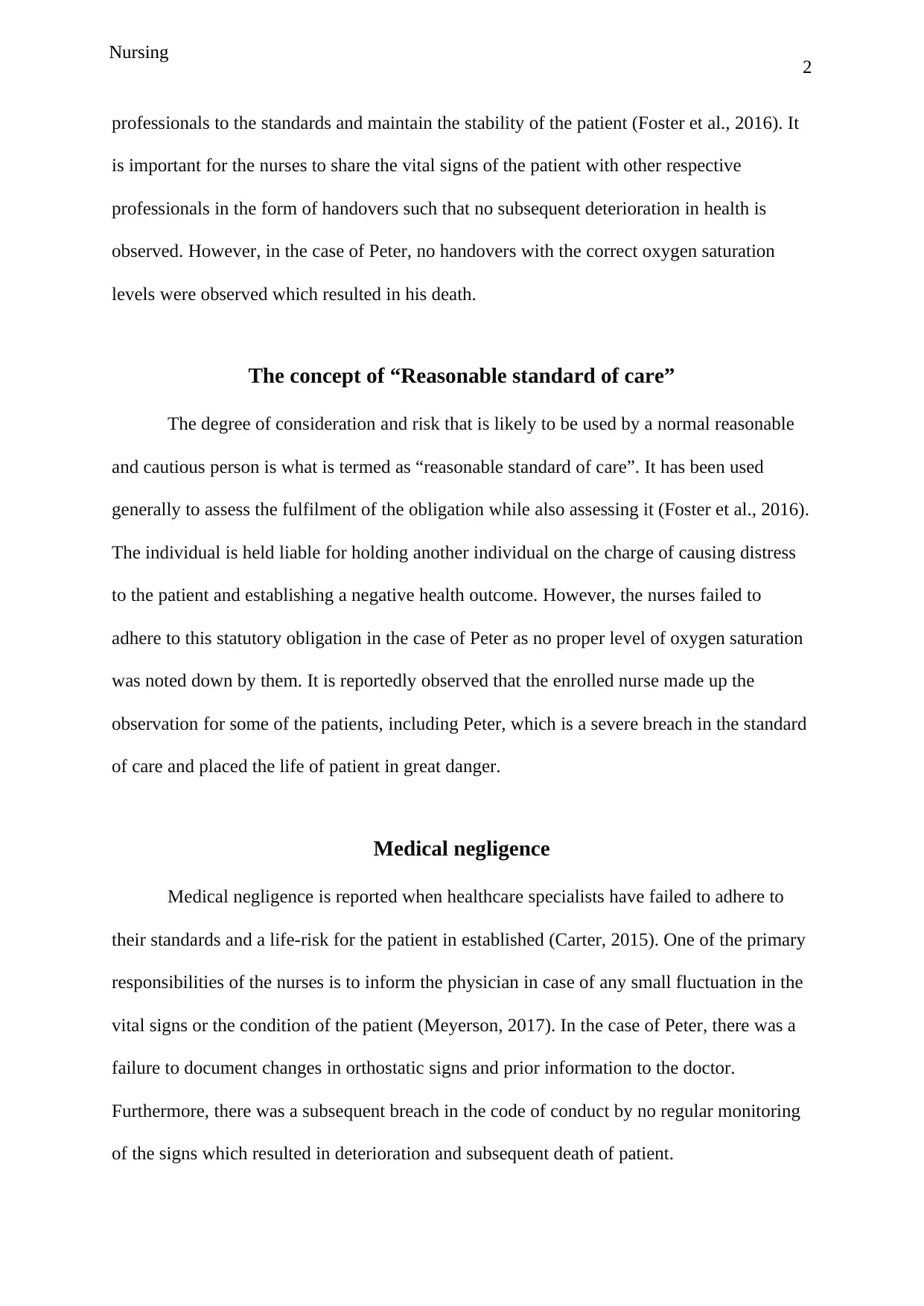
2
professionals to the standards and maintain the stability of the patient (Foster et al., 2016). It
is important for the nurses to share the vital signs of the patient with other respective
professionals in the form of handovers such that no subsequent deterioration in health is
observed. However, in the case of Peter, no handovers with the correct oxygen saturation
levels were observed which resulted in his death.
The concept of “Reasonable standard of care”
The degree of consideration and risk that is likely to be used by a normal reasonable
and cautious person is what is termed as “reasonable standard of care”. It has been used
generally to assess the fulfilment of the obligation while also assessing it (Foster et al., 2016).
The individual is held liable for holding another individual on the charge of causing distress
to the patient and establishing a negative health outcome. However, the nurses failed to
adhere to this statutory obligation in the case of Peter as no proper level of oxygen saturation
was noted down by them. It is reportedly observed that the enrolled nurse made up the
observation for some of the patients, including Peter, which is a severe breach in the standard
of care and placed the life of patient in great danger.
Medical negligence
Medical negligence is reported when healthcare specialists have failed to adhere to
their standards and a life-risk for the patient in established (Carter, 2015). One of the primary
responsibilities of the nurses is to inform the physician in case of any small fluctuation in the
vital signs or the condition of the patient (Meyerson, 2017). In the case of Peter, there was a
failure to document changes in orthostatic signs and prior information to the doctor.
Furthermore, there was a subsequent breach in the code of conduct by no regular monitoring
of the signs which resulted in deterioration and subsequent death of patient.
Nursing
professionals to the standards and maintain the stability of the patient (Foster et al., 2016). It
is important for the nurses to share the vital signs of the patient with other respective
professionals in the form of handovers such that no subsequent deterioration in health is
observed. However, in the case of Peter, no handovers with the correct oxygen saturation
levels were observed which resulted in his death.
The concept of “Reasonable standard of care”
The degree of consideration and risk that is likely to be used by a normal reasonable
and cautious person is what is termed as “reasonable standard of care”. It has been used
generally to assess the fulfilment of the obligation while also assessing it (Foster et al., 2016).
The individual is held liable for holding another individual on the charge of causing distress
to the patient and establishing a negative health outcome. However, the nurses failed to
adhere to this statutory obligation in the case of Peter as no proper level of oxygen saturation
was noted down by them. It is reportedly observed that the enrolled nurse made up the
observation for some of the patients, including Peter, which is a severe breach in the standard
of care and placed the life of patient in great danger.
Medical negligence
Medical negligence is reported when healthcare specialists have failed to adhere to
their standards and a life-risk for the patient in established (Carter, 2015). One of the primary
responsibilities of the nurses is to inform the physician in case of any small fluctuation in the
vital signs or the condition of the patient (Meyerson, 2017). In the case of Peter, there was a
failure to document changes in orthostatic signs and prior information to the doctor.
Furthermore, there was a subsequent breach in the code of conduct by no regular monitoring
of the signs which resulted in deterioration and subsequent death of patient.
Nursing
⊘ This is a preview!⊘
Do you want full access?
Subscribe today to unlock all pages.

Trusted by 1+ million students worldwide

3
Coroner
It is when the death of the patient is established to be under suspicious circumstances
or there is no possible explanation from the medical professionals of the death of the patient,
they are referred to the coroner for further investigation (Gray et al., 2016). The case of Peter
was directed to the coroner because of the circumstances under which he had died as his
oxygen saturation level in the documents has been recorded at 82%. Hence, the coroner was
unable to ascertain the cause of death.
Summary
After the effective analysis of the case study, it could be ascertained that if proper care
to Peter would have been provided, the condition of the patient could have improved.
However, because of the lapses being recorded for the ward and enrolled nurses, the health
outcome that was established for Peter was negative.
Nursing
Coroner
It is when the death of the patient is established to be under suspicious circumstances
or there is no possible explanation from the medical professionals of the death of the patient,
they are referred to the coroner for further investigation (Gray et al., 2016). The case of Peter
was directed to the coroner because of the circumstances under which he had died as his
oxygen saturation level in the documents has been recorded at 82%. Hence, the coroner was
unable to ascertain the cause of death.
Summary
After the effective analysis of the case study, it could be ascertained that if proper care
to Peter would have been provided, the condition of the patient could have improved.
However, because of the lapses being recorded for the ward and enrolled nurses, the health
outcome that was established for Peter was negative.
Nursing
Paraphrase This Document
Need a fresh take? Get an instant paraphrase of this document with our AI Paraphraser
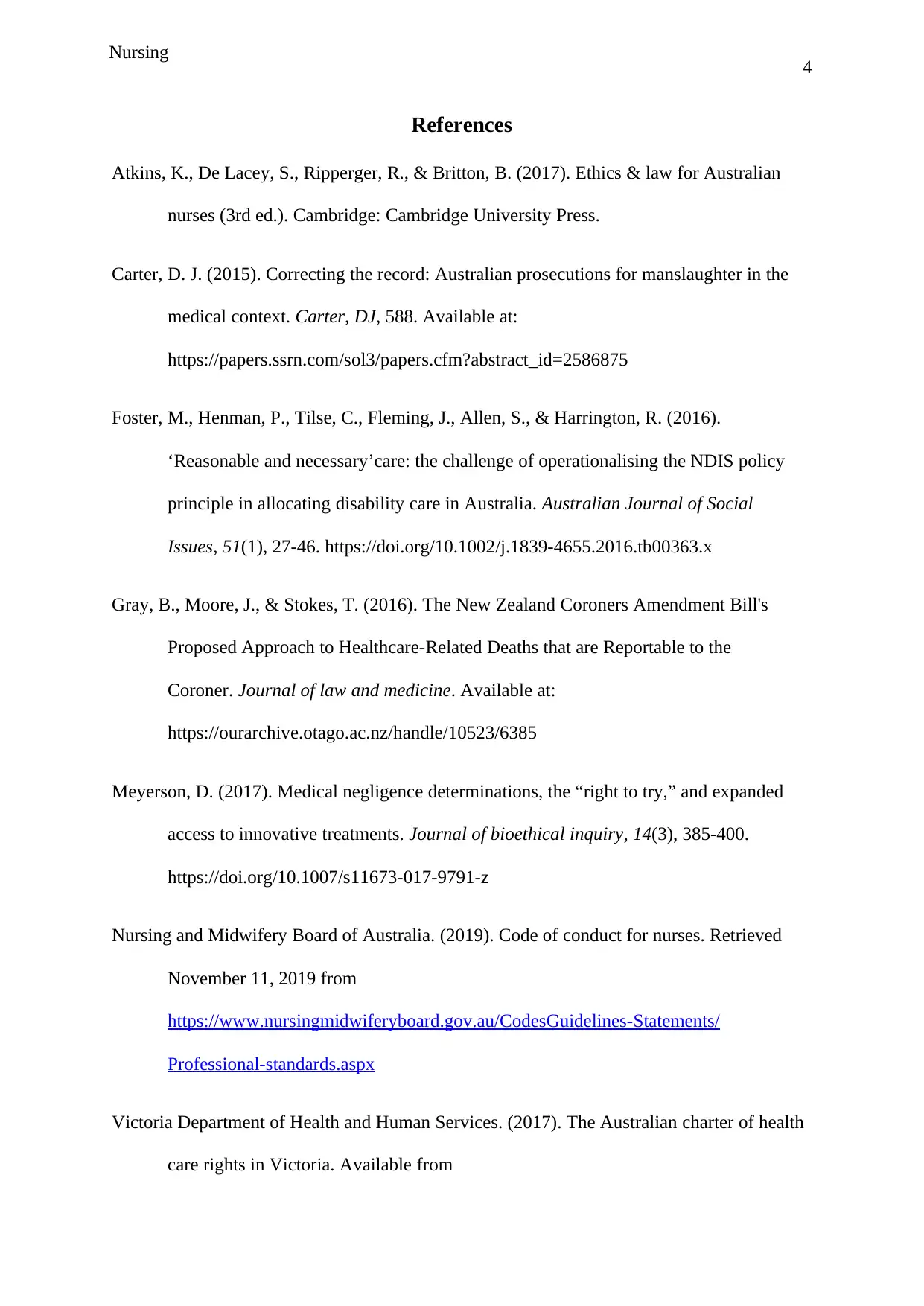
4
References
Atkins, K., De Lacey, S., Ripperger, R., & Britton, B. (2017). Ethics & law for Australian
nurses (3rd ed.). Cambridge: Cambridge University Press.
Carter, D. J. (2015). Correcting the record: Australian prosecutions for manslaughter in the
medical context. Carter, DJ, 588. Available at:
https://papers.ssrn.com/sol3/papers.cfm?abstract_id=2586875
Foster, M., Henman, P., Tilse, C., Fleming, J., Allen, S., & Harrington, R. (2016).
‘Reasonable and necessary’care: the challenge of operationalising the NDIS policy
principle in allocating disability care in Australia. Australian Journal of Social
Issues, 51(1), 27-46. https://doi.org/10.1002/j.1839-4655.2016.tb00363.x
Gray, B., Moore, J., & Stokes, T. (2016). The New Zealand Coroners Amendment Bill's
Proposed Approach to Healthcare-Related Deaths that are Reportable to the
Coroner. Journal of law and medicine. Available at:
https://ourarchive.otago.ac.nz/handle/10523/6385
Meyerson, D. (2017). Medical negligence determinations, the “right to try,” and expanded
access to innovative treatments. Journal of bioethical inquiry, 14(3), 385-400.
https://doi.org/10.1007/s11673-017-9791-z
Nursing and Midwifery Board of Australia. (2019). Code of conduct for nurses. Retrieved
November 11, 2019 from
https://www.nursingmidwiferyboard.gov.au/CodesGuidelines-Statements/
Professional-standards.aspx
Victoria Department of Health and Human Services. (2017). The Australian charter of health
care rights in Victoria. Available from
Nursing
References
Atkins, K., De Lacey, S., Ripperger, R., & Britton, B. (2017). Ethics & law for Australian
nurses (3rd ed.). Cambridge: Cambridge University Press.
Carter, D. J. (2015). Correcting the record: Australian prosecutions for manslaughter in the
medical context. Carter, DJ, 588. Available at:
https://papers.ssrn.com/sol3/papers.cfm?abstract_id=2586875
Foster, M., Henman, P., Tilse, C., Fleming, J., Allen, S., & Harrington, R. (2016).
‘Reasonable and necessary’care: the challenge of operationalising the NDIS policy
principle in allocating disability care in Australia. Australian Journal of Social
Issues, 51(1), 27-46. https://doi.org/10.1002/j.1839-4655.2016.tb00363.x
Gray, B., Moore, J., & Stokes, T. (2016). The New Zealand Coroners Amendment Bill's
Proposed Approach to Healthcare-Related Deaths that are Reportable to the
Coroner. Journal of law and medicine. Available at:
https://ourarchive.otago.ac.nz/handle/10523/6385
Meyerson, D. (2017). Medical negligence determinations, the “right to try,” and expanded
access to innovative treatments. Journal of bioethical inquiry, 14(3), 385-400.
https://doi.org/10.1007/s11673-017-9791-z
Nursing and Midwifery Board of Australia. (2019). Code of conduct for nurses. Retrieved
November 11, 2019 from
https://www.nursingmidwiferyboard.gov.au/CodesGuidelines-Statements/
Professional-standards.aspx
Victoria Department of Health and Human Services. (2017). The Australian charter of health
care rights in Victoria. Available from
Nursing
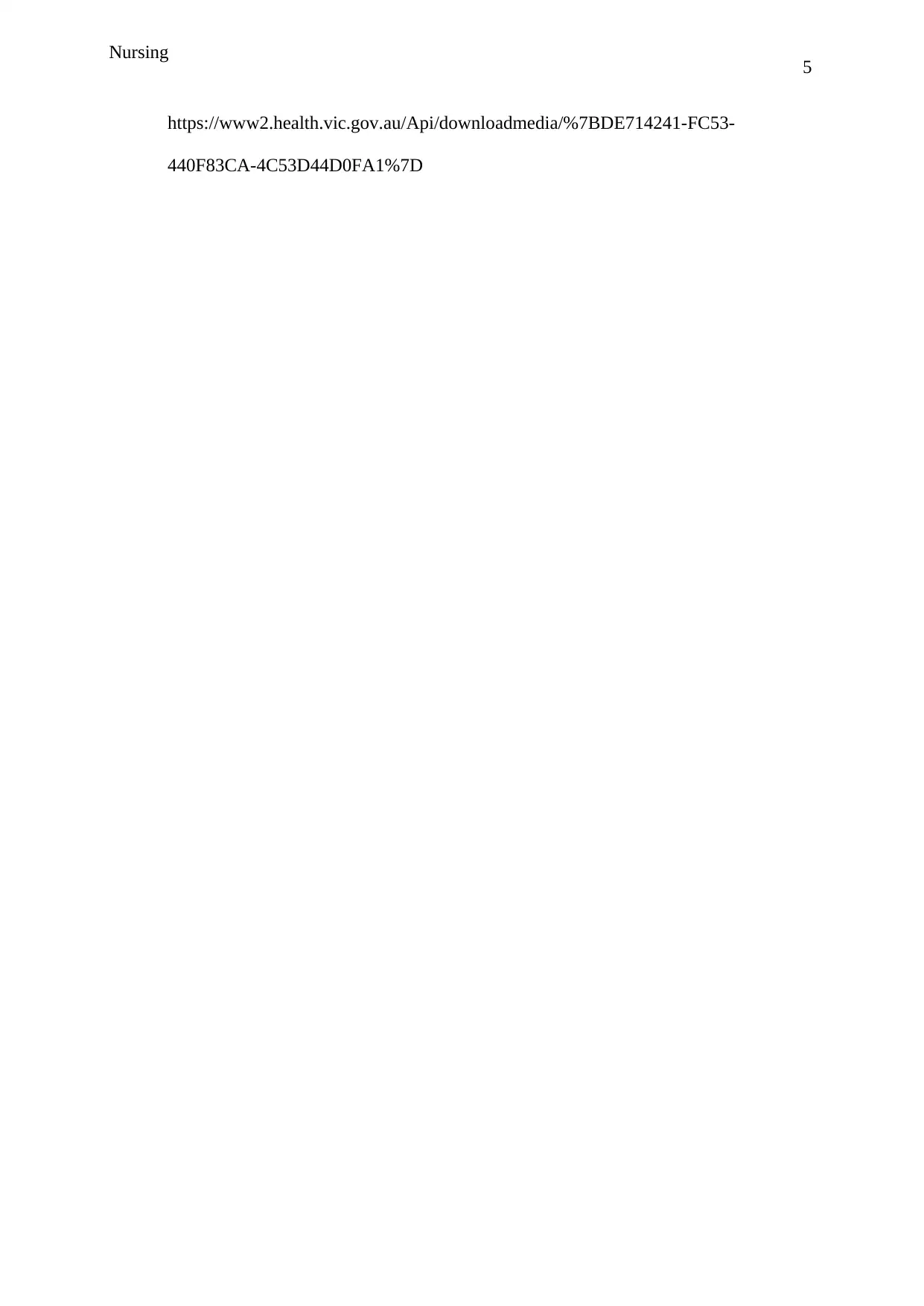
5
https://www2.health.vic.gov.au/Api/downloadmedia/%7BDE714241-FC53-
440F83CA-4C53D44D0FA1%7D
Nursing
https://www2.health.vic.gov.au/Api/downloadmedia/%7BDE714241-FC53-
440F83CA-4C53D44D0FA1%7D
Nursing
⊘ This is a preview!⊘
Do you want full access?
Subscribe today to unlock all pages.

Trusted by 1+ million students worldwide
1 out of 6
Related Documents
Your All-in-One AI-Powered Toolkit for Academic Success.
+13062052269
info@desklib.com
Available 24*7 on WhatsApp / Email
![[object Object]](/_next/static/media/star-bottom.7253800d.svg)
Unlock your academic potential
Copyright © 2020–2025 A2Z Services. All Rights Reserved. Developed and managed by ZUCOL.





